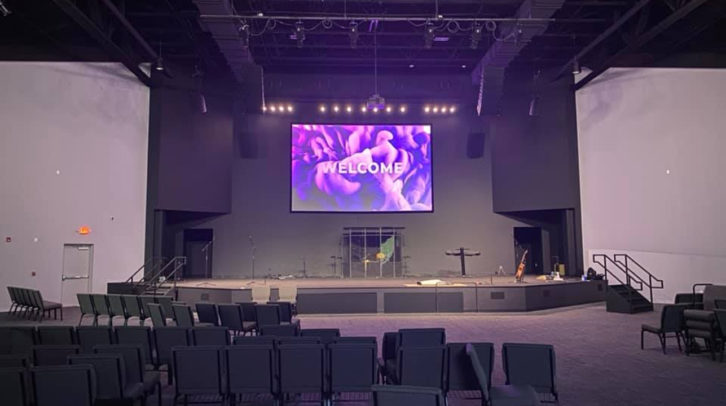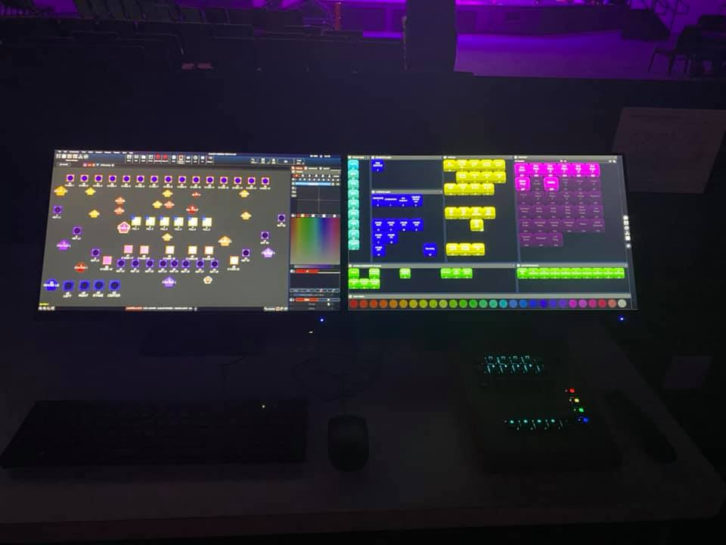
Calvary Assembly in upstate New York is a fast-growing church with an all-new worship center and a young, musical congregation. To get topnotch sound, video and lighting they called in TSH Audio Visual. Timothy Harris is with us today to give us the lowdown on how the project went during a challenging time.
SVC: Timothy, thanks for joining us from TSH Audio Visual in Syracuse, New York. Before we get into the details on the Calvary Assembly project, how about giving us a little background on TSH Audio Visual.
Timothy Harris: We’ve been around since 2014. We mainly focus on houses of worship. We have about 7 or 8 employees that are the core group of everything between designers, sales, and installers. We do a lot of northeast stuff but we will travel across the country, so I’d say we cover most of the United States. It’s just been our passion to work with churches.
Tell us about Calvary Assembly. This looks like a rapidly expanding church with a whole new building.
Calvary reached out to us. We worked with them before on their old sanctuary. We installed a Danley audio system just to get them through because they were using just column speakers that were set on the floor. They wanted something a little bit more substantial in the sanctuary because they’re modern worship. They’re kind of high energy. They wanted something to be a little more impactful. Well, fast-forward a couple of years, they were into designing a new sanctuary. We listened to what they were looking for and we came back with a design that fit their needs with sound, video and projection. They went with an architect in the Rochester, New York area–a very well-known architect. They brought us in to work with them on the AVL stuff, acoustics and design of the room.
Looks like a very young congregation with plenty of live music and video. That tends to present more technical challenges. And you had the pandemic to deal with.
We did. Because it was becoming a fast-paced project, we had to start a little earlier than we normally do. So we were jumping in behind trades pulling wire, putting rigging up for speakers and lighting and all that probably around February into March of 2020. And then it slowed down. COVID did shut us down for a couple of weeks. Up here in New York, and with all the restrictions that the governor put on us, we had to manage our time to get onsite and do what we had to do very efficiently and then leave. The trades had to get in around us so we could stick with the state mandate of social distancing and wearing masks and all that. We finally turned the building over in the beginning of July.
Likely a challenge to get coordinated with all the other trades involved with the construction.
Yeah. There were some times when we overlapped each other. A couple of times we were in there with drywallers. It’s not really optimal for us putting AV equipment in. We kept most of the larger electronic stuff until it was all painted and done, but there was some dusting to do before we were able to do a couple of things.
Yes, I can imagine. So describe the sound system you put in. Why did you go with a Martin Audio line array system?
We’ve been working with Martin for many years. Martin is one of our main line arrays we like to use in projects when the budget and the room is right for it. The Martin Audio system we installed was a left-right hang of six per side of Martin Audio Wavefront Precision WPC boxes. Those were powered by three of the Martin Audio IK42s powered left to right, with out-fills of Martin Audio CDD boxes or CDD 15s, and with front fills of CDD 6s. The subs were Danley Audio TH118XL. We had four of those across the center of the stage built into two bunkers, concrete bunkers, that were basically raised off the floor with two inches of foam. So there’s no energy really being lost, but we decoupled it from the floor so they wouldn’t get a lot of reverberation across the floor.
 You also installed a Shure wireless mic system and I believe Sennheiser IEMs.
You also installed a Shure wireless mic system and I believe Sennheiser IEMs.
The Shure mics were the QLX-Ds. The IEMs were the 500G4s, the new G4s that came out, I think, last year. I’ve always liked the Sennheiser in-ears and we’ve always had good luck with them. The Shure PSM 900s are also really good, but they wanted more of a network control so they can monitor the battery life and the signal of the mics. If you went with Shure you’d have to go with the PSM 1000. The PSM 1000 is a very, very nice unit, it just didn’t fit in the budget. So that’s why we went with the G4, the IEMs. We went with the QLX-Ds because the price point was very good with them, plus all the information that you can use on the network would show up on the A&H dLive console that we installed. So battery life, signal strength and all that would show up on the dLive when any operator wants to see what’s going on with the mics.
I would think that one of the more time-consuming parts of that installation would be running all of the antenna cable.
Yeah. We love using RF Venue. We used the Sennheiser Panel for the in-ears. The CP Beam, which is by RF Venue was kind of an aesthetic thing so we went with another panel just to make everything looks even where the antennas are all sitting.
What did you like about the Allen & Heath dLive mixing console and how did you connect the mixer with the mics?
The dLive is a phenomenal console. It’s very intuitive, 96K. It’s got many features and every couple of months they’re coming out with new features for it, so they do listen to their end users. The whole audio system is Dante, from amplifiers to console to DSP to any remote audio around the campus, it’s all Dante. So routing is real easy; just go into the Dante controller and use the route feed wherever you need to go.
Did you have any trouble getting all the AV gear delivered on time?
No. Most of the AV equipment was purchased back in December of last year. We’ve had some other projects that we’ve had to wait on products because people have literally shut down and they’re not doing anything. But everything that we spec’d out was pretty quick in getting to us, into our warehouse, and out to the customer onsite.
There’s a huge center projection screen. How did you get the video from the source to the projector?
We used all SDI. All the video camera work was all done by the client themselves. We didn’t really have a hand in that. So we ran SDI cable up to the projector – up through a Decimator converter to HDMI. The projector is the Sony 12K Laser 3 LCD projector. The screen is 20 feet by 13-1/2 in a 10 x 16 format. The screen was made by MDI/Strong out of Quebec, Canada, and it’s very large. Graphics look great on it. The 12,000 lumen projector, it’s about 22 feet back. We had to put a wide short throw on there to cover the whole thing, but I mean the grabs look amazing on this screen.
And for all that gear you have the Lyntec power sequencing?
Yep. All the power is Lyntec so audio has their own panel, which is all sequenced, and lighting has their own panel, which is all sequenced. So lighting can turn all their lighting bars off in all the outlets all across the stage. For sound, basically the AV rack shuts down; anything that doesn’t really need to be run. The only thing that really stays on in the rack is the DSP, and all the network switches, and the DMX distribution systems.
From the videos, this church seems very upbeat; they’re very optimistic about getting a full crowd into the new space.
They do have people in there now but it’s more like you have to register to go in there. They have seats six feet apart and people are getting their temperature done. They have to wear masks. You can only go in one door and out another door. They’re being very conscious of the whole social distancing and wearing masks and everything.
Yes and this is probably going to be with us for a while.
 You know, this pandemic has made a lot of changes for the church industry. Streaming has become a very important, integral part of the church culture now. There are some churches that jumped on it right when it happened and there are some churches that are trying to get to it right now. For churches that get into to it right now, it’s tough. There are a lot of vendors out there that are behind in equipment. I know a lot of the larger vendors for video, they’re pretty well stocked up. But anything that really comes from overseas is getting tough to get. You have to sometimes make compromises and get a camera that might not be what they want. So it’s become ‘this is what you need, but let me call all my vendors and see if they have anything in stock, or if they can come up with for option B, C, D and maybe E’. [Laughs]
You know, this pandemic has made a lot of changes for the church industry. Streaming has become a very important, integral part of the church culture now. There are some churches that jumped on it right when it happened and there are some churches that are trying to get to it right now. For churches that get into to it right now, it’s tough. There are a lot of vendors out there that are behind in equipment. I know a lot of the larger vendors for video, they’re pretty well stocked up. But anything that really comes from overseas is getting tough to get. You have to sometimes make compromises and get a camera that might not be what they want. So it’s become ‘this is what you need, but let me call all my vendors and see if they have anything in stock, or if they can come up with for option B, C, D and maybe E’. [Laughs]
So what does TSHAV have coming up?
We’re doing a lot of small projects now like screens and projectors, some streaming stuff. We do have a larger project coming up this month. We did a church last December, the Love Joy Church, and we’re going back to put a new AV system in their kids’ sanctuary.
Well, it’s been great listening to how you got this one done. I’m glad that you got all your equipment before the big rush. Sounds like you’re still hanging in there and still making it work.
You know, God’s blessed us in everything and what we’re doing. Hopefully 2021 is going to be an even better year. We keep on growing every year. We love what we do and we’re going to keep on moving forward.










